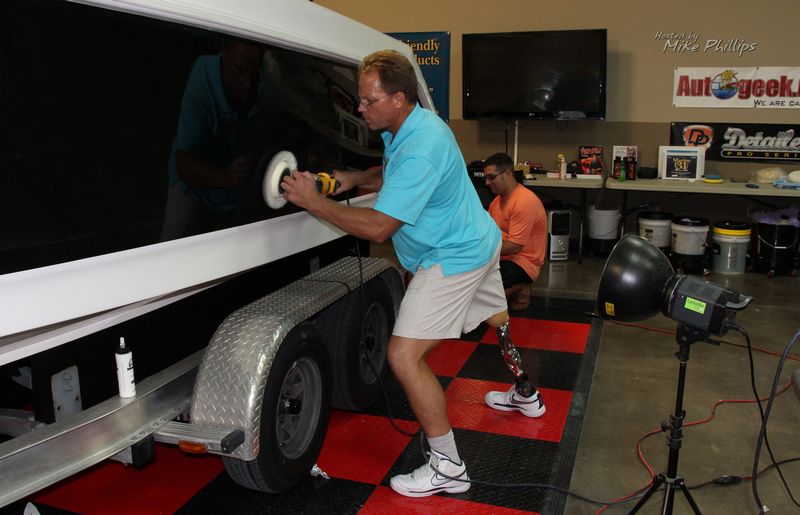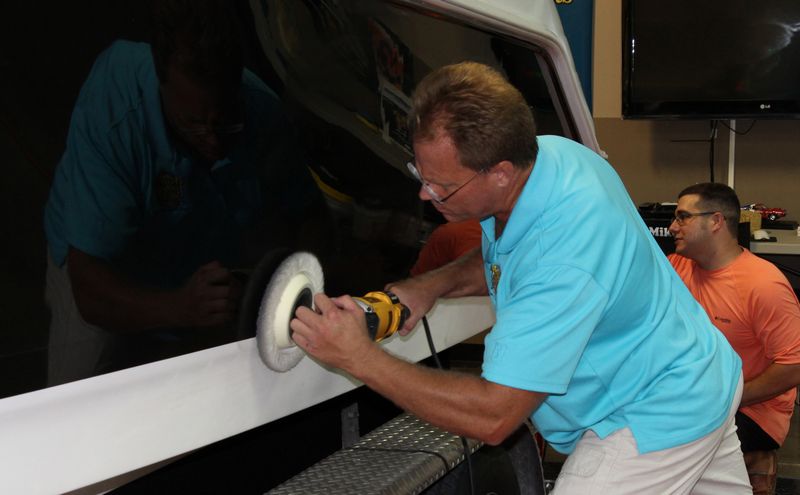Mike Phillips
Active member
- Dec 5, 2022
- 51,004
- 7
Can't remove dull, hazy oxidation from my 1983 Formula Gel-Coat Boat?
Anytime I get questions via e-mail, a PM or a FB message I prefer to invest my typing time where
A: It's easier for me to share links, pictures and videos.
B: More people can read and thus benefit from the information. (no just one set of eyeballs
So I get an e-mail asking,
Hey Mike!
Love watching all your videos and love Autogeek in general! Great company!
I moved down here back in June and brought my 1983 Formula boat down about a year ago. We moved from a suburb of Chicago, where we used it on Lake Michigan (Fresh water). It was bought brand new in '85 and was meticulously kept clean and always covered.
Now with it being down here for a year so far, it's looking very hazy/milky.
We've tried different Marine 31 compounds but can't seem to restore it to the nice gloss we used to have. I was just at Detail Fest and picked up another product and after just trying it I still don't see any improvements.
I'm reaching out to you today to see if either you can point me in the right direction or if even you would like to use this boat for one of your classes/product showcase videos. We would be willing to pay as well for your time and expertise.
I've attached a few photos that I can find currently. We'd love to hear from you!
Thanks,
Matt
Here's Matt's boat, a 1983 Formula






Hi Matt,
Here's the deal....
When gel-coat oxidizes, it's both on the surface and IN the gel-coat, the worse it is the DEEPER it goes into the gel-coat. The deeper the oxidation the more aggressive you have to get. In my classes, I bring I boats MUCH worse than yours and then show the class how to remove the oxidation by machine sanding. The reason I show the sanding approach is because both approaches will remove the oxidation but when you machine buff >you< are going to PUSH HARD for hours to get the job done. when you machine sand, you hold the polisher lightly against the surface and let the machine do the work. It's called,
Working harder than working smarter....
Here's and example of what I mean, Jim is machine sanding, notice how he's not pushing hard...


See all the pictures from this once-a-year class here,
Click here to see ALL the pictures from the 2018 Boat Detailing Class and you'll see just how hands-on these classes are!
The above is just one way to skin a cat, there are a million.
My first question however is,
How were you applying the product you bought?
Type of tool?
Type of pad?
This makes a HUGE difference as to how the products will work, or not work.

Anytime I get questions via e-mail, a PM or a FB message I prefer to invest my typing time where
A: It's easier for me to share links, pictures and videos.
B: More people can read and thus benefit from the information. (no just one set of eyeballs
So I get an e-mail asking,
Hey Mike!
Love watching all your videos and love Autogeek in general! Great company!
I moved down here back in June and brought my 1983 Formula boat down about a year ago. We moved from a suburb of Chicago, where we used it on Lake Michigan (Fresh water). It was bought brand new in '85 and was meticulously kept clean and always covered.
Now with it being down here for a year so far, it's looking very hazy/milky.
We've tried different Marine 31 compounds but can't seem to restore it to the nice gloss we used to have. I was just at Detail Fest and picked up another product and after just trying it I still don't see any improvements.
I'm reaching out to you today to see if either you can point me in the right direction or if even you would like to use this boat for one of your classes/product showcase videos. We would be willing to pay as well for your time and expertise.
I've attached a few photos that I can find currently. We'd love to hear from you!
Thanks,
Matt
Here's Matt's boat, a 1983 Formula






Hi Matt,
Here's the deal....
When gel-coat oxidizes, it's both on the surface and IN the gel-coat, the worse it is the DEEPER it goes into the gel-coat. The deeper the oxidation the more aggressive you have to get. In my classes, I bring I boats MUCH worse than yours and then show the class how to remove the oxidation by machine sanding. The reason I show the sanding approach is because both approaches will remove the oxidation but when you machine buff >you< are going to PUSH HARD for hours to get the job done. when you machine sand, you hold the polisher lightly against the surface and let the machine do the work. It's called,
Working harder than working smarter....
Here's and example of what I mean, Jim is machine sanding, notice how he's not pushing hard...
See all the pictures from this once-a-year class here,
Click here to see ALL the pictures from the 2018 Boat Detailing Class and you'll see just how hands-on these classes are!
The above is just one way to skin a cat, there are a million.
My first question however is,
How were you applying the product you bought?
Type of tool?
Type of pad?
This makes a HUGE difference as to how the products will work, or not work.

